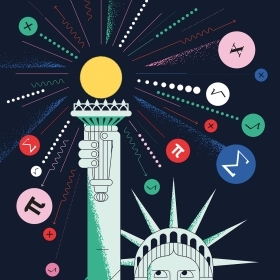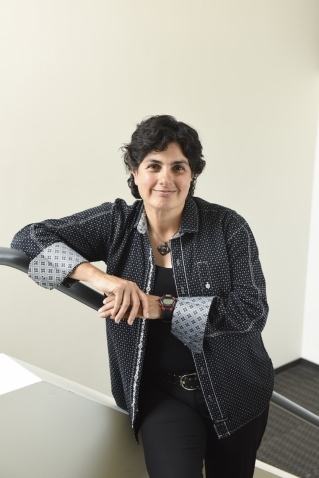当伽利略在大约400年前向天空转向天空时,这是一个范式转移的时刻 - 不一定是因为他所看到的,而是因为如何。突然,人类可以进入更多宇宙,而不是肉眼可见,在随后的年度,科学家们致力于建立更大和更好的望远镜,更大更详细地探讨宇宙。然而,一系列的天体上面的用途挑选了它们:像黑洞和中子恒星一样密集的物体,它们根本不会放弃任何光线,也认为它们甚至是最强大的望远镜。
Then, in 2015, the paradigm shifted once again—scientists successfully captured two black holes colliding by detecting the gravitational waves produced by the impact. In the thick of a discovery that can only be described as monumental was an unlikely player: a Pakistani-American, openly gay, female astrophysicist named Nergis Mavalvala ’90, who began working on the Laser Interferometer Gravitational-Wave Observatory (LIGO) project as a Ph.D. student at Massachusetts Institute of Technology, and quickly established herself as a leader in the field.
当发现展开时,它是什么样的?“疯狂的。完全疯狂,“Mavalvala回忆道。“Our first reaction when we saw the signal was, ‘Oh, this is a mistake or a glitch in our instrument, but not something real.’ There was this frenzy of everyone checking their own work and then others cross-checking their work.” The excitement mounted over weeks and months as the scientists determined that indeed, for the first time, LIGO had detected gravitational waves from a celestial object: ripples in the space-time continuum produced when such an object accelerates through space. The findings confirmed Einstein’s Theory of Relativity, which had predicted that massive objects in space would give off gravitational waves.
研究人员六个月后宣布了他们的发现,科学永远不会是一样的。“从现在开始的一百年,人们不会真的记得利奥诺是第一个看到这些碰撞黑洞的”Mavalvala Posits“。“现在真的是范式的转变,而不是只能看到明亮的东西,我们也可以看到黑暗的宇宙。”
那么Mavalvala如何结束现代时代最重要,复杂的研究工作之一的领先优势?她的旅程开始于巴基斯坦卡拉奇的成长,她回忆起宇宙的起源感兴趣,但宗教和社会解释完全不满意。“我记得,从幼儿期间,思考,创世纪的各种叙述与太阳系年龄的简单科学观察甚至是一个简单的科学观察,”她说。“我想我试图理解这些反对的叙述,对我来说,科学的人似乎更具可测试了。”
At the same time, Mavalvala was cultivating her natural aptitude for math and science in school while spending her free time pursuing her interest in building and fixing: making things out of spare parts, repairing bicycles. Not realizing that she could have a career as a scientist, she assumed she would become an engineer.
这一切都在Wellesley改变,她花了三年与物理学教授罗比伯格进行研究。“这是我在物理实验室工作的第一个品味,我记得这是任何人可以做的最有趣的事情 - 我可以在这里和一天中的一天,它感到正确,”她回忆起。她的研究专注于了解相对未知但有前途的半导体的性质,通过在其晶体结构中寻找缺陷来了解称为铝镓砷化镓的性质。
当然,它并不总是顺利帆船。Mavalvala的第一件事之一是打破激光......种类。在仪器上清洁镜子,Mavalvala热情地同时删除所有这些,而不是每次协议的时间。这花了一个星期的激光再次工作,但是Mavalvala学到了一个有价值的课程:“我总是告诉我的学生,如果你也没有打破某些东西,你就不会在尖端。”
然而,Wellesley仍然是对Mavalvala的研究。她在校舍南瓜队中磨练了她的竞争优势,在体育中心花了这么多时间,即前台的女性如果她错过了一天。她还在斯拉特国际中心的家里找到了一个家的家园,并在Wellesley和MIT之间来回骑自行车的习惯,太不耐烦地处理公共汽车。“我觉得很多我的身份,即使在今天,那么有点凝胶在那里,”她说。
在从Wellesley毕业后,在天文学和物理学中的双重专业后,Mavalvala向她的博士学位前往麻省理工学院。“我知道我想做物理学。我没有那么结婚物理学的哪个部分,事实上利波在我的雷达上无处可去,“她回忆起。“当我第一次听到它时,我加入的那一天。”
那天在1991年来到1991年之后,在马瓦瓦拉的原始顾问离开麻省理工学院,让她的购物留给实验室。她遇到了Rainer Weiss,现在是MIT的Emeritus Physics教授,以及诺贝尔劳特基为Ligo的贡献。在会议期间,她回忆起,韦斯在他的桌子上有了脚,嘴里的管道,并问她,“好吧,你知道什么?”随着Mavalvala响起了一份先进的物理课程,Weiss阻止了她并澄清,“但你知道该怎么办?”米瓦拉然后告诉他关于修理成长的自行车,建筑电子产品,并在Wellesley使用机器商店,他邀请她加入他的实验室。“我曾经逗乐并困惑,”麦拉拉说。为了他的部分,魏贼有力出现了提出要约的简单原因:“我可以看到她决心,她被Zippy,这使得世界上所有的不同。”
随着Weiss拍摄Mavalvala的Ligo项目,它仍然在其启动阶段,“我实际上认为这是完全疯狂的 - 我认为任何人都不能用这种精确度进行这样的测量,”她说。但是,但我在这一天之前想到了这一天,我觉得如果你能做到这一点,那就太棒了,而不仅仅是一种技术壮举,而且能够用重力看宇宙的科学而不是轻盈。“
There are two LIGO detectors in the United States, the Hanford Observatory in Washington State and the Livingston Observatory in Louisiana. Each is shaped like an L, with each “arm” of the L extending 4 kilometers (roughly 2.5 miles.) At the end of each arm is a 35-centimeter diameter, 40-kilogram mirror that is perfectly aligned to face a similar mirror at the corner of the L. Laser beams are used to continually compare the distance between the two mirrors on each arm. As gravitational waves produced by celestial objects like black holes pass through the earth, the distance between the mirrors on each arm changes by 10^-19 meters—one ten-thousandth the width of a proton—which the laser beams can then detect.
该项目的主要挑战是检测引力波引起的镜子几乎难以察觉的运动,同时确保镜子由于一些其他力而不是未对准或移动。对于她的博士学位,Mavalvala开发了一种感知镜子方向的系统,并完全对齐它们。“这是我们在Ligo中所有问题中最困难的最困难之一,如何让所有镜子对齐,因此它们都指向正确的方向。”Weiss说。“你必须用巨大的精度自动做到这一点。”Malvalvala的系统今天仍然用于探测器。
虽然建议她,韦斯来意识到飞行器alvala possesses two traits he considers critical for any successful scientist. “She has good ideas, but also has the persistence to make it happen,” he says. “When something’s not right, she finds out what’s wrong and she fixes it. And she doesn’t give up—she is as stubborn as a mule.”
完成博士后。1997年,Mavalvala将她的技术娴熟和坚韧的实践职业道德致力于加州理工学院,她继续致力于利罗,首先是博士后研究员,后来作为一名员工科学家。在那里,她帮助建立了Ligo探测器,在华盛顿或路易斯安那州每月花费约25天。“这也许是我生命中最有趣的时期之一,因为我们正在从头开始建造一些东西,我们正在做一些从未以前从未完成过的事情,所以我们在发明中,我们是发明的,”她说。“我觉得有巨大的努力尝试想法,因为我们正在做一些如此困难的事情。”
在此期间,她与Ligo首席科学家Caltech的Stanley Whitcomb密切合作。“我可以立即看到她有一种渴望和闪闪发光,这将需要很长的路,”他回忆道。“不仅对她的技术能力增长,还有巨大的尊重,也是她与各级人民合作的能力。NERGIS是第一个人,如果他们需要对他们解释的东西有关探测器如何工作的事情,那么这些人都可以更加接近,并且可以比大多数人更好地解释事情。“
In 2002, as the detectors got up and running and the project expanded to include thousands of scientists all over the world, Mavalvala accepted a faculty position at MIT, where she has continued working on LIGO while leading a team of graduate students and postdoctoral researchers. Unable to spend as much time at the sites, she carved out a piece of the project related to quantum mechanics to tackle in the lab. Quantum mechanics is a fundamental theory of physics that attempts to describe nature at its smallest scale. Quantum uncertainty, a principle of quantum mechanics, states that we cannot know the exact location of microscopic particles like electrons and protons due to their natural jittering.
然而,即使利焦镜相当大,“事实证明,当您尝试在该精确度进行测量时,量子力学很重要,”Mavalvala解释说,由于量子不确定性意味着用于测量微观变化的激光镜子之间的距离如此略微略微,从而限制了测量的精度。(Mavalvala将其描述为试图测量一张纸张用尺子持续摇动的标尺。)
“在我们的团队在麻省理工学院,我们一直在做一些被称为量子工程的东西:我们正在开发比普通激光器更好的光源,通过使用量子工程的想法,”Mavalvala说。
One of the group’s major developments is “squeezed light”: laser light that overcomes the limitations of quantum uncertainty in measuring the distance between the mirrors. To do this, the laser light becomes extremely precise in one property that the researchers are interested in measuring—namely the arrival rate of the high-energy photons that make up the laser beam—by sacrificing precision in another property the researchers don’t need to quantify—specifically, the total number of photons in the beam.
“即使我们说话,我们的学生也在Ligo上安装了第一个在Ligo上的挤压光源,因此当它回来后,当此目前的关闭后,它将是一个量子增强探测器,”Mavalvala说,增加了她的工作也有对诸如量子计算的其他量子测量系统的影响。事实上,Mavalvala于2010年赢得了麦克阿瑟奖学金(A“Genius Grant”)于2010年为她的研究,韦斯和韦斯斯担任推出了一个名为宏观物质的量子物理学的新领域。
有了一个杰出的科学职业生涯,跨越了大约三十年的职业生涯,毫不奇怪的是,马瓦尔瓦已成为她代表的群体的榜样,包括科学和奇迹和移民社区的妇女。虽然Mavalvala对这个想法并不完全舒适,但她赞赏她可以通过公开生活和毫无保留,而她可以毫无保留地产生积极的影响,这是她唯一知道的方式。“不知何故,只是因为我是谁,它可以在鼓舞人心的方面对人们有所作为,这是他们想要的人,这是一件好事,”她说。在群众,群众的Mavalvala享受着弥撒。这些天,她的生活在很大程度上围绕着工作和家庭。虽然她没有多少时间南瓜,但她到处都是自行车,在Wellesley的日子里听到了回到她的日子。
至于她的科学愿望,Mavalvala无意放慢她的追求,以发现无论宇宙仍然隐藏在视线之外。“自然给我们发信号,他们是他们所在的,所以我们的工作要始终在考虑,我们如何衡量这些?”Mavalvala解释道。“我喜欢的是考虑可以挑逗自然秘密的乐器 - 你如何设计一个可以告诉你新鲜工作的新东西的实验。”





我们要求那些从事Wellesley杂志的在线社区的人,诚实,诚信和尊重。(记住荣誉代码,明矾?)我们保留删除非意外人或意见的意见,这些意见不是民间和与手头的主题相关的意见。通过发布在此处,您允许Wellesley Magazine在所有媒体中编辑和重新发布您的评论。请记住,所有帖子都是公开的。